Being a great server at a restaurant isn't just about ensuring the guests get their orders on time, or smiling as you guide them towards their designated tables. It's also about focusing on the finer details of their customer experience, after all studies show that customers prefer a more personal interaction during their restaurant visit.
The best restaurateurs realize inspiring the best from their top servers is as critical to the success of their business as having a great menu and great ambiance.
The good news is that truly great restaurant servers are made, not born. They fulfill a customer's underlying needs through hard work, desire, and professionalism. Put simply, every server out there has the potential to live up to guests' expectations – they just need a bit of extra training.
Whether you want to hone the serving skills of your staff or train them to lead by example, following a few tricks can help them be the best at their job.

11 Tips for being a better restaurant server
Wondering how to be a better server? We've compiled some of the best restaurant industry tips to help you become a great server. Before you can start working towards becoming the best server, you need to start by perfecting the basics of the job.
The following steps highlight the essential skills required to be an effective server.
1. Know the menu
An important thing to remember is that your servers are the main touchpoint for the diners and are often the only ones with direct contact with them.
It's crucial that they are well versed about everything that's on the menu and know it inside out so that they can answer any questions posed by the diners, or they will be running around the floor trying to get clarity.
This includes knowing exactly what's on the menu and the ingredients of each dish in order to assist the diners with allergies & dietary preferences. If you aren't sure, be polite and let them know you'll find out for them, don't leave them hanging with a blunt "I don't know".
2. Be prepared for grunt work
A good server is always ready to put in the work regardless of the nature of a task. You'll see them doing crappy jobs that people hate doing like filling condiments, restocking napkins, and preparing dining room linens without complaining and that's what sets them apart.
You too can help prepare your servers for grunt work by making them run their plates, clean their section, and do any other non-core tasks you have in store.
Incorporating jobs that lack glamor and prestige will help you test your servers' limits to see how much they want to excel and how much they can take. Also, it'll enable you to see which servers are okay with working crummy shifts and hours that everyone typically hates.
Good servers are usually ready to take whatever sections/tables/tasks their managers give them.
3. Memorize the specials
While you might think to yourself that customers should be able to figure out what they want to order, many patrons need a little prodding or just want to know what's good on the menu. As such, good servers need to be familiar enough with the restaurant's specialties and top-selling items to describe them in detail.
Of course, you don't want to build unreasonably high expectations (e.g., “This is the best rib-eye steak you'll ever have!”), but customers do appreciate that you know your dishes.
And if you must play it safe, you can always train your servers to apply suggestive selling by mentioning dishes that are popular with other customers. Does the mulligatawny soup on your menu resonates well with your regulars? Suggest that to first-time guests.
4. Turn every customer interaction into an opportunity
Train your staff to make the most of their interactions with guests. One of our better server tricks is to offer free amuse-bouche.
Think about it, who doesn't love getting a free teaser of the chef's style before their meals even hit the tables? By providing guests with a complimentary amuse-bouche, a great server can invoke a sense of appreciation without spoiling guests' appetites and increase the likelihood that they've just earned a repeat customer.
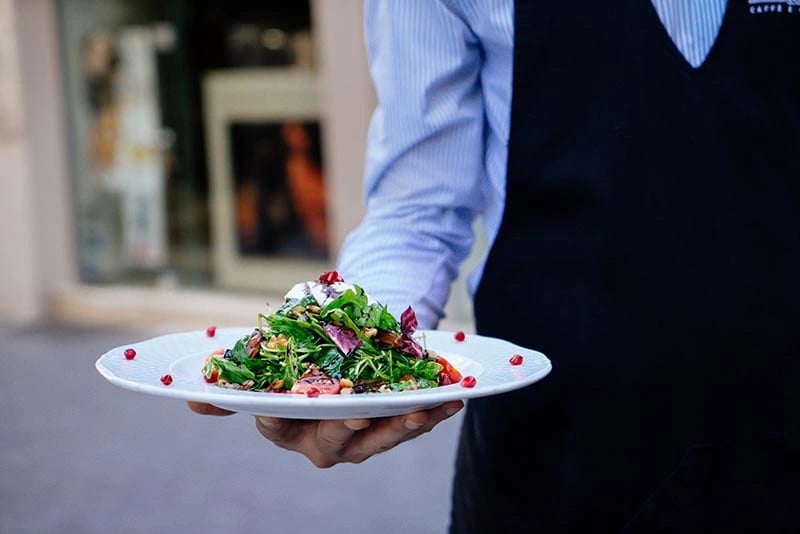
An amuse-bouche will also come in handy when servers have to suggest an extra side dish or one of the highest margin menu items later on. Because guests feel like they've already caught a break by getting something for free, they're more likely to order a high-priced item from the menu. This, in turn, will help your entire restaurant increase revenue.
5. Be proactive in your service
Most servers know that some guests are unbelievably easy to handle while others sitting at separate tables can be incredibly difficult. What they aren't aware of are the steps they can take to make things go as smoothly as possible when do get a high maintenance group.
For example, after they serve guests on one of their tables, rather than asking whether patrons need anything in general, they can ask about specific items such as refills, utensils or condiments.
By specifically calling items out, servers can minimize their trips over an extra spoon or a bottle of ketchup because the diner forgot to request it the first time around. Also, a great server can make your restaurant appear as detailed oriented and genuinely caring of its guests.
Moreover, it goes without saying, but refilling a guests water glass before it's empty (and not using the same glass for multiple drinks) is always an indication of good service and shows that you've employed top servers at your restaurant.
6. Follow proper presentation and etiquette
Servers who know how to follow proper etiquette and present themselves and your food are a brilliant asset for your restaurant. This begins with ensuring their attire is pressed and they're appealing for guests to look at.
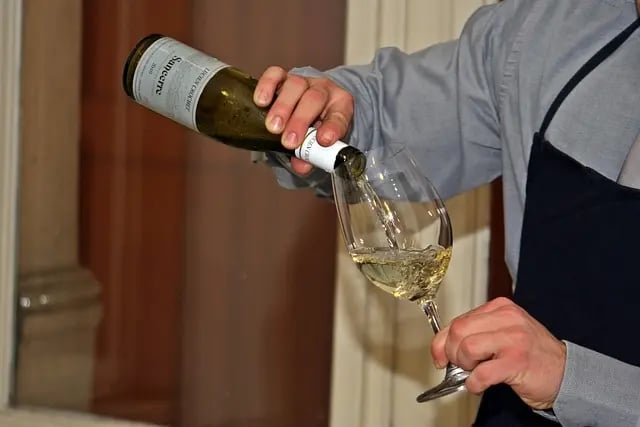
Additionally, a good server must get food and wine presentation right. For example, wine glasses shouldn't be filled too high, and ample headspace should be given for the wine to aerate without sloshing.
In general, an effective presentation can make an average restaurant look good and a good restaurant looks great. Hence, make sure to train your servers on getting all of the details right. From the correct placement of place settings and glassware to starting food service on the left, your servers must not leave any gaps in your presentation.
7. Use your reservation system to provide better service
Your restaurant reservation system is the key to managing your guest experience from start to finish. If you're trying to be a better server, it's important to know your reservation system inside and out and be able to leverage the information it provides to reduce unhappy guests and increase repeat customers.
.webp?width=1052&height=526&name=SDR%20Welcome%20Email%20(1).webp)
Depending on which reservation management system a restaurant uses, new hires might be asked to demonstrate how well they know how to use the system, this is more important for some of the bigger reservation software providers (Eat App, OpenTable, Yelp).
When a reservation management system is used correctly and paired with a pos system, a good server is able to minimize wait times (turning tables faster), prepare for special requests ahead of a guest arriving, make a personal connection with a warm greeting and eye contact, track every guest and their most common orders and even receive feedback after service to address customer complaints.
8. Get the necessary certifications and training
In many locations, restaurants must ensure their servers have obtained food handling or alcohol serving certifications before they can work on the floor. On your first day as a server, ask your manager about the required certifications, the deadline to complete them, and if you can work while completing the courses (which may vary depending on location).
Having an alcohol serving certification for example, though not mandatory everywhere, is a beneficial choice for servers and bar staff. The Serv-Safe Alcohol Course is one example of a program that provides important information. As a server, serving alcohol is a part of the job, so it's essential to understand how to promote responsible drinking and maintain a safe environment for guests, fellow staff, and oneself.
As a server, look into online or in-person certifications/classes that could help you provide a better dining experience for your guests.
9. Minimize mistakes (Get into the habit of double checking orders)
It's always better to verify an order with a guest rather than waste kitchen resources and make them wait for a new dish. Here are two tips to reduce order errors:
-
If you have any doubts about the order, don't hesitate to approach the table and politely ask for clarification. Most guests will appreciate your attention to detail.
-
After entering the order into your POS system, take an extra minute to double-check for accuracy and completeness. This will minimize food waste, increase efficiency, and guarantee guest satisfaction.
10. Upsell without being pushy
Upselling involves trying to persuade guests to choose more expensive items or a greater quantity of items, thus increasing the overall bill. Upselling at the right moment is a simple act that should feel like having a meaningful conversation with your guests.
Here are some simple tips for upselling:
-
Recommend starters: Often times, suggesting a specific dish is much better than asking if your guests want a starter in general. Eg, "Could I interest you in our house salad to get you started?"
-
Suggest extras: Anytime a guest orders a menu item that can be upgraded at an additional cost, ask them if they'd like to opt for the extras. Eg, "Would you like to add cheese to your burger? We can also get you some sauce on the side if you'd like".
11. Learn how to handle allergies
With over 32 million Americans struggling with food allergies, it's a common reality in the restaurant industry. The majority of food-allergy-related reactions are caused by eight main allergens: wheat, soy, milk, eggs, tree nuts, peanuts, fish, and crustacean shellfish. As a server, it's likely that you will encounter guests with food allergies at some point during your shift, and it's even more likely that your menu includes one or more of these allergens.
To ensure a safe and satisfying dining experience for all, restaurants have put strict food-allergy protocols in place. As a server, it's crucial to not only be familiar with these protocols but also to proactively ask each table if anyone has a food allergy. This not only minimizes the risk of contamination in the kitchen, but it also shows your dedication to providing exceptional customer service.
Reservation and table management systems like Eat App help take the guess work out of tracking allergies by allowing servers to tag reservations and guests with allergy tags. This prevents any incidents from occurring if a customer asks for a menu item that they don't realize contains one of their allergens.
How a good restaurant server can get more tips
If you're a server wondering what you can do to get bigger tips, here are a few pointers to help get you started.
-
Provide excellent service: The most important factor in determining the size of a tip is the quality of service provided. Servers should aim to be prompt, friendly, and attentive to their customers' needs.
-
Build a rapport with guests: Servers should strive to make a personal connection with their guests. Engage in conversation, ask about their day, and make them feel comfortable and appreciated. This can lead to a more positive dining experience and higher tips.
-
Offer suggestions: Servers should be knowledgeable about the menu and be able to make recommendations based on a customer's preferences and dietary restrictions. By offering suggestions, servers show that they are paying attention and are invested in their customers' satisfaction.
-
Upsell: Servers should be comfortable with upselling, without being pushy. Suggesting additional menu items, such as a dessert or after-dinner drink, can increase the customer's bill and, in turn, the server's tip.
-
Be efficient: Servers should aim to be quick and efficient, without sacrificing quality. This includes accurately taking orders, delivering food and drinks promptly, and clearing tables in a timely manner. Customers appreciate prompt service and are more likely to leave a higher tip as a result.
By implementing these tips, restaurant servers can increase the tips they receive and provide a better dining experience for their customers.
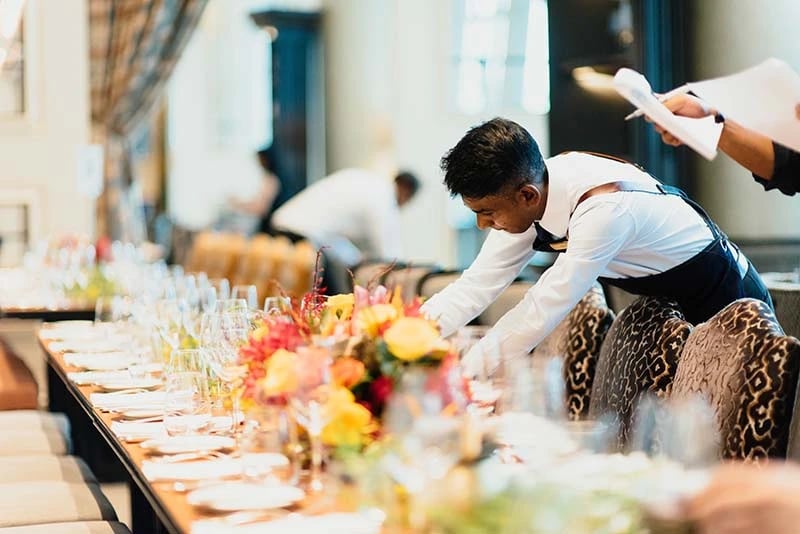
5 ways to train staff to be better servers
As a restaurant manager, you can invest in server training to help create an effective, knowledgeable workforce. Servers who are trained to identify customer's underlying needs and who have extensive menu knowledge to fall back on will be able to provide service that feels thoughtful, personal, and authentic. Below are a few ideas for pulling it off.
1. Arrange a session for menu tasting
One of the best ways to begin server training is to arrange a menu tasting session for your staff. After all, servers can't provide recommendations or answer menu-related questions if they've never actually tasted the items.
At the end of the weekly meeting, managers can invite staff members and do a menu tasting with them. This is also a great time to discuss allergen information, recap the frequently asked menu questions, and sample a variety of popular entrée options.
Even the simplest of menus still require briefing from time to time, and your servers should be as knowledgeable about the menu as possible. Menu tasting will help them get a feel of a cuisine's actual taste and figure how a regular customer may react to it.
Only then they'll be able to provide genuine answers and suggestions about a food item when guests come inquiring.
2. Make new servers shadow an experienced employee
If you're recently hired new servers, make sure they perform a shadow session or two with the most experienced members of your staff. During shadow training, the novice server is essentially an intern and the credit for any tips earned goes to the trainer.
Interns note how the trainer speaks with customers, their tone of voice, their posture, their facial features, etc. Every tiny detail is crucial and if your restaurant is popular for upselling promotions, presenting specials, or even describing the aperitivo of the day, make sure the trainee knows the right way to manage these things.
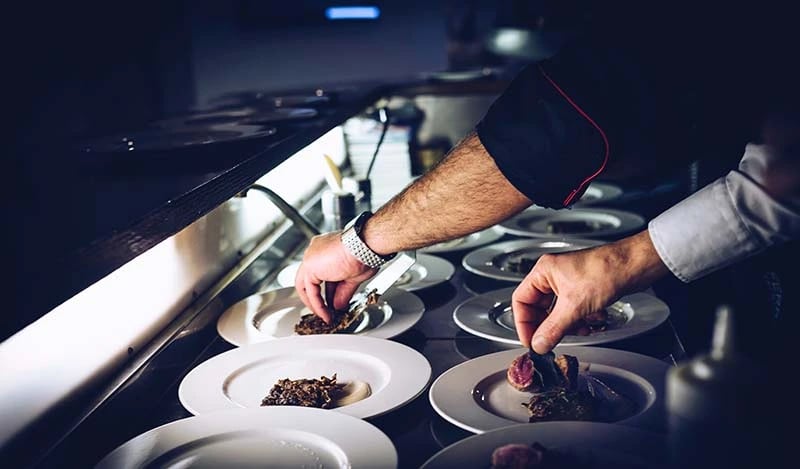
Also, when it comes to running food and drinks and picking up the speed, make sure the trainee gets familiar with the pace of your particular establishment and knows how to keep up with it.
During waiter or waitress shadowing, make sure the trainer helps interns to become aware of the most important parts of the restaurant, such as the kitchen, dry and cold storage, etc. Taking this step will help prevent a good server from running late and going into areas that could include blind spots for staffers carrying full trays of meals.
3. Create a server training manual
There are so many factors that affect the failures and success of restaurant servers, so you can't neglect the value of a great server training manual. This manual should list out everything from the mission statement of your restaurant to safety policies.
As the restaurant manager, this is your chance to pass on information about what your eatery stands for and the values it wants to uphold. The manual can even include scripts for how the serving staff should present your restaurant to the guests.
It's worth noting that restaurant servers are not the best salespeople, so the training manual can also include tips that will help them encourage customers to order desserts, beverages, and upgrade meals with high-margin menu items.
Make sure everyone involved understands the importance of upselling and the perks of meeting their goals. Will they get a bonus for achieving a specific number of upsells? Make sure to highlight this in the training manual in order to increase server motivation.
4. Provide some space to assess progress
If your trainees are catching on quickly and doing their job well, back off and let them take the lead. See how they work without supervision. Let them commit a few mistakes so that they learn while making sure they don't affect your restaurant's dining experience
It's okay to give servers a little nudge now and then such as “What are you forgetting about that customer” or “Where are you supposed to start service from?” But other than that, let them take the wheel for a bit.
Additionally, you can conduct a performance review to evaluate servers' progress. For example, you can ask customers to leave a quick comment about the serving, hosting, and food once they are done with their meal.
Trainers can also help create performance reports which contain information and data collected monthly, weekly, and daily. From these insights, you can assess the performance of each personnel.
restaurant management software can also come in handy for gaining insights about your servers and to track & assign tables to them.
5. View training as everlasting
Many of the initial guidelines, such as the serving style to implement and the restaurant etiquette, may change over time, so it's important to adopt a continuous approach to server training.
The ultimate task throughout the training is to make sure that the restaurant is in compliance with new industry regulations and whatever is taught is actually implemented.
Many times, servers go through the training, only to find out that their new skills are outdated on the floor. By designing a continuous training program, you can help equip great servers with the latest etiquette and practices.

Here are some of the outcomes you can expect from continuous training:
-
Better awareness of changing practices
-
Adequate knowledge of the menu
-
Successful identification of the restaurant's most valuable customers
-
Improved compliance with sanitation and safety guidelines
As restaurant owners or restaurant managers, you need to know that your servers are the face of your business. Not only do they interact with the guests during hosting or service, but they also promote your restaurant in other ways, including food presentation, etiquette, and style of service.
By constantly honing the abilities of your servers and helping them stay up-to-date with industry standards, you can help them become better at their job, more tuned in to what customers want, and more efficient at taking steps to increase restaurant revenue.
Conclusion
As a restaurant owner or manager, you need to know that your servers are the face of your business. Not only do they interact with the guests during hosting or service, but they also promote your restaurant in other ways, including food presentation, etiquette, and style of service.
By constantly honing the abilities of your servers and helping them stay up-to-date with industry standards, you can help them become better at their job, more tuned in to what customers want, and more efficient at taking steps to increase restaurant revenue.
FAQs about being a good server
To help recap the article above with more tips, we're answering some of the most common questions about becoming a better server.
To become a fine dining server, gain experience in the restaurant industry by starting in a casual or mid-range restaurant and learning about customer service, food and drink knowledge, and table service. Study the art of fine dining and obtain a food service or wine certification to demonstrate your knowledge and commitment. Network with other servers, practice and refine your skills, apply for fine dining positions, and be flexible and adaptable to changes in the fast-paced fine dining environment. With these steps, you can develop the experience, knowledge, and skills required for success in this role.
When greeting a table, approach them with a warm and welcoming smile to set the tone for the dining experience. Introduce yourself, let the guests know your name, and offer a brief greeting. Ask if they have dined with you before and if it's their first time, take a moment to explain the menu and offer recommendations. Show that you are paying attention to their individual needs and wants by asking if they have any special requests or needs. Present the menus, offer them to the guests, and step back to give them a moment to look over the options. Before taking their food order, confirm their readiness to order by asking if they have any questions or need more time to look over the menu. This type of greeting helps create a positive atmosphere and ensures that the guests feel welcomed and well taken care of.














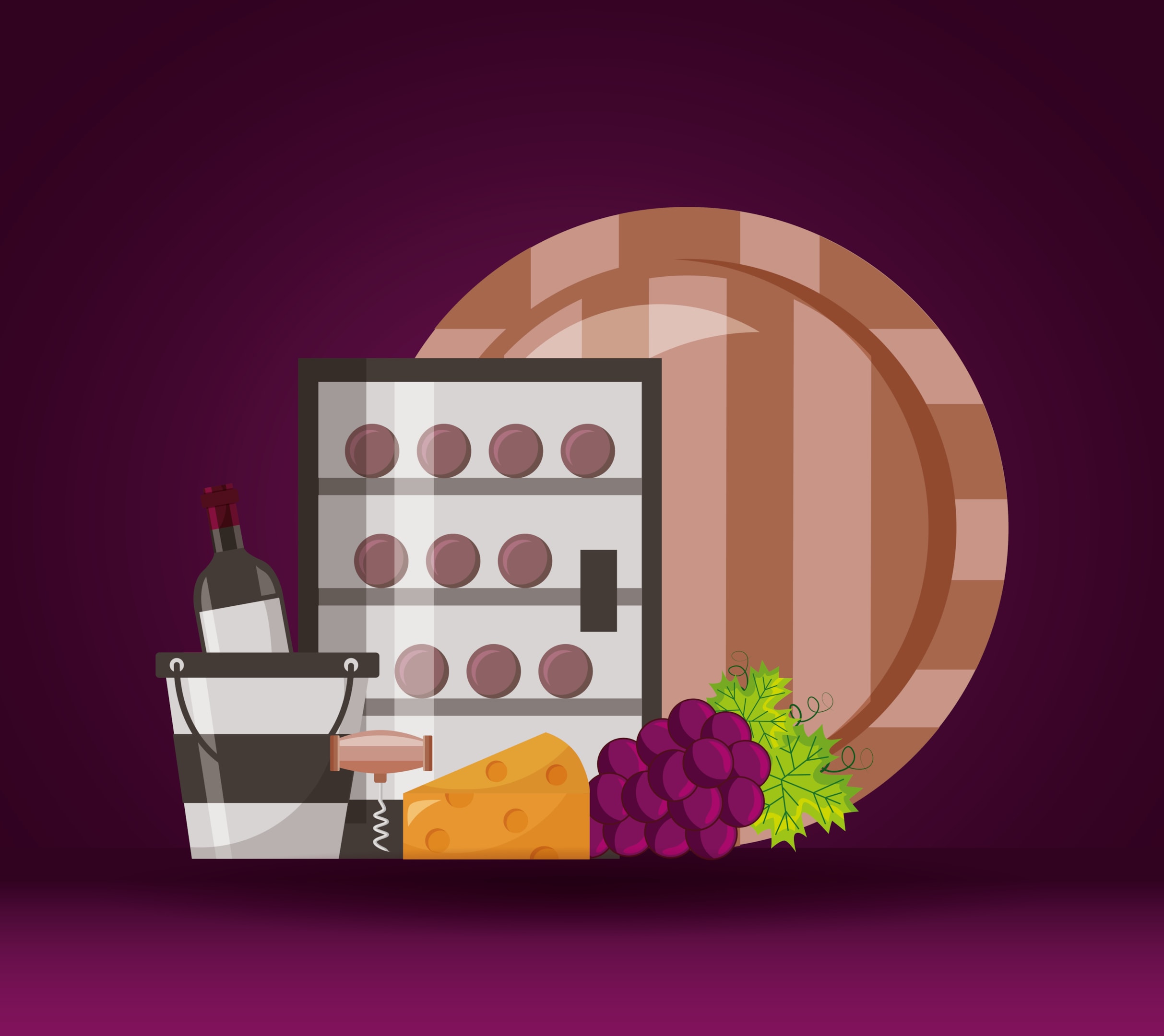
-1.png?width=1812&height=1072&name=TripAdvisor%20%26%20More%20Bookings%20(1)-1.png)
-2.png?width=1812&height=1072&name=Google%20Bookings%20(1)-2.png)


-1.png?width=200&name=TripAdvisor%20%26%20More%20Bookings%20(1)-1.png)
-2.png?width=200&name=Google%20Bookings%20(1)-2.png)
-1.png?width=200&name=Instagram%20Bookings%20(1)-1.png)
-1-png.webp?width=200&name=Facebook%20Integration%20Rectangle%20(1)-1-png.webp)







.webp?width=200&name=download%20(1).webp)
%20(1)-2.webp?width=200&name=Eat%20(34)%20(1)-2.webp)
%20(1)-2.webp?width=200&name=Eat%20(18)%20(1)-2.webp)





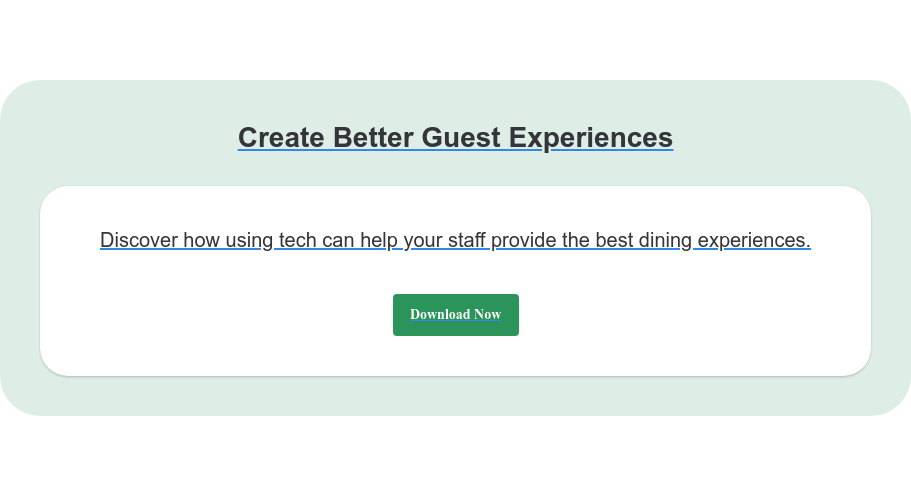



.webp?width=314&height=175&name=Chit%20Printer%20Banner%20(8).webp)



.webp?width=144&height=72&name=Eat%20App%20Logo%20(3).webp)